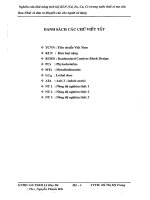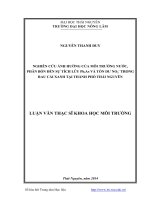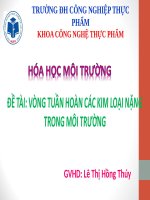26_amfabfuajfneaf kln
Bạn đang xem bản rút gọn của tài liệu. Xem và tải ngay bản đầy đủ của tài liệu tại đây (2.9 MB, 36 trang )
Market Sizing North America
Intelligent & Integrated Technologies
Excellence in Market Intelligence
1
1
Market Sizing North America
Intelligent & Integrated Technologies
Overview for CABA
IIBC at AHR2010
Jan. 25, 2010
Market Sizing North America
Intelligent & Integrated Technologies
Level 1 sponsors
Level 2 sponsors
Excellence in Market Intelligence
3
3
Experienced Project Team
Andrew Giles, MA
General Manager
BSRIA - World Market
Intelligence (WMI)
Jeremy Towler, BBA, HTEC,
dipl. Oek. Senior Manager
Intelligent Building Technology
Lone Hansen
Senior Manager
I.T. Cabling and
Associated Technologies
Gambi Chiang, MSc, BEng, MCIM,
Charter Marketer
Senior Manager Special Projects
Sukant Rout, BEng(Telecom), MBA
Senior Market Research Consultant:
Intelligent Building Controls / IT
Cabling & Associated Technologies
Ianire Cobeaga, MBA
Market Research Consultant
Intelligent Building Technology
Allan McHale, CEng, MIMechE,
MIst Energy, MBIM.
Independent Consultant
Excellence in Market Intelligence
4
4
Study Objectives
Purpose
Detailed assessment of current and future markets around
intelligence in non-domestic buildings in North America
Quantitative and qualitative market assessment, segmentation,
competitor analysis, routes to market
Size markets for principle applications plus integrated and ITconverged solutions
Scope
1.
2.
3.
4.
5.
IT Convergence
Environmental Controls
Lighting Controls
Security Systems
Fire Detection Systems
Timetable
June – Dec 2009
Excellence in Market Intelligence
5
5
Key Findings
Environmental (HVAC) Building Controls
The market will compete in applying BAS to tackle climate change issues
Companies need to obtain and disseminate both controls and IT
knowledge
Lighting Controls
Huge savings and market potential
Consolidation to provide total lighting solutions and more integration
LED lighting is a growing market but controls required for better
efficiency
Security Systems
CCTV / Video surveillance setting the pace, followed by access control
Strong movement towards IP systems and integration of security systems
Fire Detection and Alarm
Robust, growing market, driven (and constrained) by codes & regulations
Demand for better evacuation solutions will drive integration of nascent
mass notification / voice evacuation market
Excellence in Market Intelligence
6
6
$20 Billion Systems* Market 2009
$8.5 Billion Market for Products* (incl. cable & cabinets) 2009
*
*
Systems = Product + Value Add (Engineering, Commissioning,
Installation) excluding maintenance
Products = Hardware, Software, Cable and Cabinets
at first point of distribution prices
Excellence in Market Intelligence
7
7
End-user Sectors
Top vertical markets:
Education
13%
Offices
12%
Central / Local Government
11%
Health
Excellence in Market Intelligence
9%
8
8
IBC Markets will Rebound
Depressed economy, lack of
credit, increasing building
vacancies
Fall in new construction,
delayed refurbishment and
retrofit
However, IBC* markets have
outperformed
Economic stimulus will help
boost demand – particularly
public sector
IBC* markets expected to
return to growth late
2010/early 2011
USA
US$ Bn.
Source: Economist/ US Census Bureau
Canada
Source: StatCan
* Intelligent Building Controls
Excellence in Market Intelligence
9
9
Definition Convergence
Convergence is to bring together autonomous
systems onto a common communication
platform within the business enterprise and
create a single unified solution
Network = Ethernet Cat 5/5e/6 and/or fibre
IT network/
backbone
BMS structure
Excellence in Market Intelligence
10
10
Definition integration
Integration is to add value by
joining or linking different
building services products
However nearly all integrated
solutions are also converged at
least at management level
- many also at control level
Service layer (IP
provider)
IT-Networks
IT-Convergence
Management level
(Mostly IP)
Automation/control layer
(IP/BACnet/LON/proprietary)
Integration
Automation/control layer
(IP/BACnet/LON/proprietary)
Technical Infrastructures
(HVAC/Lighting/Security/Fire etc.).
Excellence in Market Intelligence
11
11
Total system market $20 billion
8%
converged
(IT) only
34%
integrated
and
converged
BMS
21% on a separate
BMS infrastructure
• 56% = stand-alone
• 44% = integrated
and/or converged
2%
integrated
only
IT
13% on the IT network/backbone
Excellence in Market Intelligence
12
12
Stand-alone vs. integration/convergence by
product area, US$ million, 2009
7,000
6,000
5,000
4,000
3,000
2,000
1,000
0
BMS
Lighting
(controls)
Stand alone
CCTV
Integration
Access
control
Convergence (IT)
Intrusion
Fire and
safety
Convergence (BMS)
Stand alone is high for lighting, intrusion and fire (~90%)
IT convergence only – 25% for CCTV, 6% access
Integration and convergence high for BMS (54%) and access (45%)
Excellence in Market Intelligence
13
13
Forecast 2009 – 2013, % split by stand-alone
vs. integrated and converged
100%
90%
80%
Stand alone
70%
60%
50%
Integrated only
40%
- Convergence IT
30%
20%
- Converged BMS
10%
0%
2009
2010
Excellence in Market Intelligence
2011
2012
2013
14
14
Trends
Intelligent buildings not a new topic, but new attention to
energy usage and building performance
Many corporations increasingly take centralised decisions and
need more and better information
Government wants to reduce CO2 emissions and energy
consumption
Technology advancements are key drivers e.g. IP, wireless, PoE
IT barriers (lack of bandwidth, security) solved!
Scope and expertise increasing, integration/convergence of
products
A number of companies can now take on the role of Master SI
(the outcome however still depending on the person in charge)
Data centres are becoming more intelligent
Excellence in Market Intelligence
15
15
Smart Grid - Definition
An intelligent electricity system that connects all
supply grid (utilities) and demand elements (endusers) through an intelligent communication system
Excellence in Market Intelligence
16
16
Barriers
Resistance from FM and from IT to converge
(stick to own areas of expertise and competence)
Lack of training and skills
Construction process uses traditional route with
main contractor and sub-contractors
Long-term outsourcing contracts
Historic objections relating to the IT
infrastructure e.g. security, downtime, bandwidth
Excellence in Market Intelligence
17
17
2 Main Drivers of Convergence
1
Energy and building
performance
2
Energy savings and
efficiency
Improve building
performance (better
decisions)
Security
Higher level of security
(physical and IT security
converged)
Efficient data sharing
Remote access
Reduce maintenance
costs
Improving storage
Increase the value of the
building/rental revenues
Access cards a
requirement
Link data sharing
between departments
Excellence in Market Intelligence
18
18
Who is driving convergence?
BMS
IT
Securi
ty
Large projects 90%-100% converged at
management level (Ethernet)
IT convergence not perceived a benefit by
many BMS suppliers
IT suppliers keen to drive IT convergence
- Cisco: Mediator and hardware
- IBM: software, consultancy and Master SI
- Oracle, HP, Plexus etc. offer
software/advice
- Integrated in BMS offering
- Driven by IT (hardw, cabling
suppliers/channel)
- Security SI/installers high end drive it
Excellence in Market Intelligence
19
19
Who is driving convergence?
Energy
rating
schemes
Political/
economic
factors
Endusers
Most converged buildings are in US
LEED silver/gold/platinum
- International pressure to reduce
CO2
-Government funded projects
-Buildings consume 70% of
electricity and 40% of primary
energy
- Pressure from society and clients
to have a green profile
- Reduce energy costs
- Improve building performance and
management
A driver for convergence, but not necessarily IT convergence
Excellence in Market Intelligence
20
20
The Main Systems Integrators
IBM
IBC(e)
IBC(l)
IBC(s)
IBC(f)
Honeywell
Honeywell
Diebold
Honeywell
Johnson Controls
Johnson Controls
Convergint
Siemens
Schneider Electric
Schneider Electric
Honeywell
Tyco
Siemens
Siemens
Johnson Controls
UTC? (GE Security)
UTC
UTC
Niscayah
CISCO
Siemens
Schneider Electric
Tyco
UTC
Oracle
HP
Others, Accenture,
Plexus, Wipro etc.
Excellence in Market Intelligence
21
21
Building Controls Product Trends
Sensor
Better automatic control require more sensors
Demand for smart sensor
Demand in CO2 sensor
Demand for all-in-one sensor
Controller
42% are web-enabled controllers, mainly automation
level controllers
End-users demand for standard protocol controllers
Multi-protocol controllers
Wireless
Still a very small market, mainly for sensors, < 5%
Industry sees the potential in room solution
Standards: Zigbee, 805.12.4, 6LoWPAN, EnOcean
Key issues: energy demand, data transmission
capacity
Excellence in Market Intelligence
22
22
Trends in the Installed Building Controls
System Market
Growing demand for integration of various
building controls system to a centralized one
Increased share of smaller scaled contract
Reduced contract size due to OEM packaged
supply
BACnet will continue to challenge LON’s share
Proprietary system will continue to diminish
Penetration of LON in smart meters
Excellence in Market Intelligence
23
23
Development of Integrated Building
Management Systems (IBMS)
Integrate with sub-systems
Integrate with other systems
Integrate with other BAS
Integrate with other enterprises systems
Open Standards Enabling Convergence
Excellence in Market Intelligence
24
24
Development of IBMS
Integration with sub-systems is the norm
Centralized monitoring and control more common
Integrated systems are mostly IT converged
Share information to improve building and
enterprise performance
Integrate for the purpose of energy saving
Driven by end users and ROI is the critical factor
Better recognition of the benefits of integration
in:
– Banking, transportation, education, health, high-tech
manufacturing, life science, communication and data
centre sectors
Excellence in Market Intelligence
25
25









